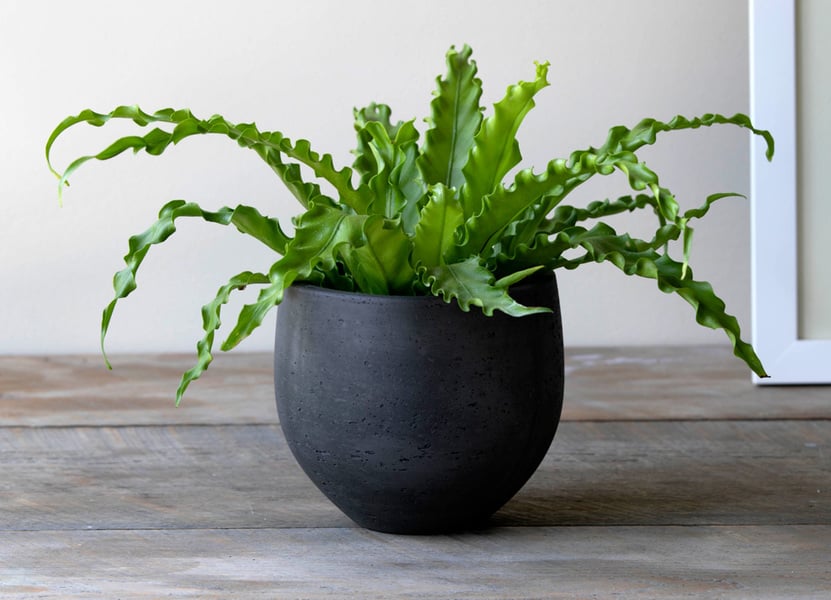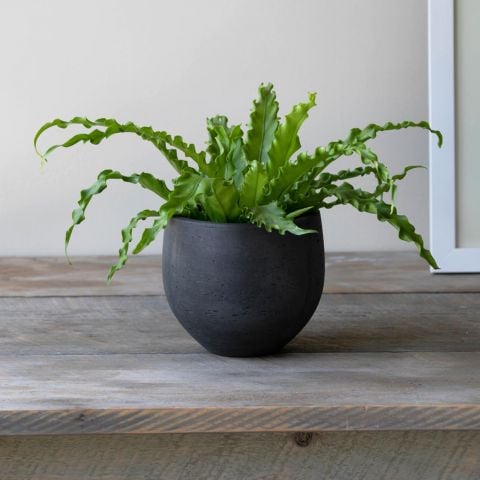Bird’s Nest Fern Care (Asplenium Nidus)

Latin Name: Asplenium Nidus
Latin Name Pronunciation: a·splee·nee·uhm nai·duhs
Asplenium nidus features wide, wavy green fronds that resemble seaweed. New growth emerges from the fuzzy center, resembling birds in a nest, hence the nickname, “Bird’s Nest Fern.” There are multiple Bird’s Nest Fern varieties available, including the Victoria Bird’s Nest Fern, and Crispy Wave Plant. There are several other, related species of Birds Nest Ferns as well.
Some Bird’s Nest Ferns originate from tropical rainforest climates across the globe, spanning from Hawaii to Madagascar, while the Asplenium hybrid, ‘Austral Gem’ is native to Australia. In the wild, these epiphytic ferns grow in the forks and crooks of other trees. As houseplants, they are renowned for their unique foliage and easy care.
These houseplants prefer environments that mimic their tropical homes, with indirect light, moderate temperatures, and medium to high humidity, making them ideal for terrariums or bathrooms.
Light/Watering
Some Bird’s Nest Ferns, such as ‘Chrissie’ and Victoria prefer bright, indirect light while Austral Gem prefers low (filtered) light. At home, keep your Bird’s Nest Fern in a room with an east-facing window or filter bright sunlight through a sheer curtain to best replicate their natural environment. Avoid placing your plant anywhere it will receive too much direct sunlight as the sensitive leaves can burn. The fern’s fronds can help you detect whether your plant is receiving the correct amount of light as the fronds will be more wavy in low light and flatter in high light. If the plant receives too much light, its fronds will turn yellow and die.
Water your Bird’s Nest Fern as necessary to keep the potting mix evenly moist but not soggy–typically when the top 1” of soil is dry. Allow water to saturate the potting soil and drain out to ensure the plant is adequately moist. Never water the center of the fern, as this may cause water to pool and harm the plant. Instead, be careful to apply water directly to the soil around the base of the plant.
These plants also benefit from moderate humidity when grown indoors. The best way to increase the humidity around your plants is to run a humidifier nearby. You can also set plants in trays filled with pebbles or gravel. Add water to a level just below the tops of the pebbles, being careful not to let the water come in contact with the potting mix which could cause oversaturation and root rot. Refill trays frequently to replace water lost through evaporation.
Soil/Fertilizer
Bird’s Nest Fern is an excellent choice for terrariums as its roots are accustomed to getting moisture from the air. If you choose to pot your Bird’s Nest Fern, opt for a loose potting medium that will allow the roots to move freely. Soil addendums such as vermiculite, peat, sand, and charcoal can help prevent compaction while providing moisture regulation for your plant.
The best fertilizer for Bird’s Nest Ferns is a balanced houseplant fertilizer. Dilute to half strength and fertilize your Bird’s Nest Fern monthly during active growth periods (April-September), being careful to apply the solution directly to the soil, not to the fronds or plant center. Withhold fertilizer in fall and winter, when most plants rest.
Indoor Ferns We Offer:
 Victoria Bird's Nest Fern in black stone cachepot
Victoria Bird's Nest Fern in black stone cachepot
Pruning
Bird’s Nest Ferns do not require much pruning. If the older, lower fronds start to become scraggly, you can remove them at the base with sharp, clean pruning shears.
Pests
Bird’s Nest Ferns are subject to the same problems as many houseplants. If you notice spider mites or mealybugs on your plants, rinse all fronds under cold running water then spray with a natural insecticide, such as neem oil. Check plants regularly for telltale signs of pests, such as white residue or webs–if caught early, they are easy to treat.
Diseases
If Bird’s Nest Ferns do not have sufficient drainage, they may suffer root rot. If roots develop an odor or appear brown and soft, stop watering your plant and allow it time to completely dry out. If the roots remain soggy for too long, the plant will develop leaf drop and eventually die.
Bacterial Blight is a common fungus that affects Bird’s Nest Ferns. Signs include small spots that form on the fronds, grow and become purple, then spread along leaf veins. If you notice signs of bacterial blight, immediately prune affected fronds to help prevent spread. If the fungus spreads too far, the plant will die and must be destroyed to prevent spread to other houseplants.
Troubleshooting
Brown Tips. If your Bird’s Nest Fern develops brown tips, it may not be receiving enough water. Be sure to water thoroughly whenever the top inch of soil is dry. If air is dry, consider misting your fern and/or running a humidifier to provide additional moisture. Fronds may also develop brown tips if they are exposed to low temperatures or drafty air, so keep them away from air vents and windows in the winter.
Yellow Fronds. If you notice your Bird’s Nest Fern’s fronds yellowing, take a look at its moisture levels. If the fronds are yellow and droopy, immediately stop watering and check to ensure that your plant has adequate drainage. If overwatering continues, the plant may develop a brown center and die. Alternately, if the fronds are yellow and dry, the plant may not be receiving enough water; be sure to water regularly and thoroughly whenever the top inch of soil becomes dry.
Brown Center. If your Bird’s Nest Fern becomes waterlogged, it can develop crown rot where the center becomes brown and eventually dies. Ensure your plant has adequate drainage and sunlight, and only water when the top inch of soil is dry to the touch. Never water directly into the center of the plant as this can cause root rot.
Propagating/Transplanting
Propagating Bird’s Nest Ferns can be quite difficult; as such, many gardeners prefer to purchase new plants rather than to undertake the process of propagating them. Propagation requires a mature plant with mature spores. If your Bird’s Nest Fern has a frond with spores, cut the frond from the plant and place it in a brown paper bag. After a few days, the spores will detach from the frond and collect in the bag. Place spores in a small pot of sphagnum peat moss, misting daily until they germinate. Germination typically takes about 2–3 weeks. Once spores become seedlings, plant in fresh potting mix and water consistently for three to four weeks.
Mature Bird’s Nest Ferns do not typically require repotting as their roots tend to remain small. If your plant is becoming top-heavy, you may want to transplant to a larger pot that will help balance the voluminous growth by simply replanting with additional potting mix.
Calendar of Care
Spring
- Water when the top 1” of soil is dry.
- Fertilize monthly with houseplant fertilizer diluted to one-half strength.
- Re-pot if the plant becomes too top-heavy.
Summer
- Water when the top 1” of soil is dry.
- Fertilize monthly with houseplant fertilizer diluted to one-half strength.
Fall
- Water when the top 1” of soil is dry.
Winter
- Water when the top 1” of soil is dry.
Frequently Asked Questions
Can Bird’s Nest Fern be grown outdoors?
Since it’s a tropical plant, Bird’s Nest Fern can be grown outdoors year-round in the balmy climates of USDA Hardiness Zones 12 and 13. Elsewhere, it can be placed outside during the heat of summer but be sure to bring it back indoors before temperatures start to dip below about 60ºF.
Is Bird’s Nest Fern a flowering plant?
No, Bird’s Nest Ferns do not produce flowers. They are renowned for their unique ruffled foliage that emerges like a fountain from a central rosette.
Is Crispy Wave the same as Bird’s Nest Fern?
“Crispy Wave” is one common variation of Bird’s Nest Fern which features characteristic sword-shaped fronds. Other variations include the “Crissie”, which has tiny hand-like forks at the end of its fronds, and the “Victoria”, which features tongue-like fronds.
Is Bird’s Nest Fern toxic to cats?
No, Bird’s Nest Ferns are not toxic to cats, dogs, or humans. These make a great choice if you have pets or children in the home.
Are Bird’s Nest Ferns easy to care for?
When given the right potting mix and environment, Bird’s Nest Ferns are relatively easy to care for. Most common problems stem from excesses of water or light, so keep your plant in a location with indirect sunlight and water occasionally for the best results.
What are the Bird’s Nest Fern health benefits?
As with most houseplants, Bird’s Nest Ferns provide excellent air purifying benefits. They also help increase indoor humidity and decrease temperatures.


